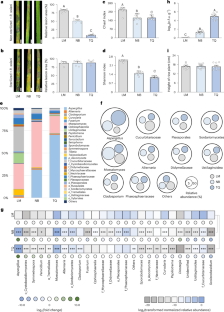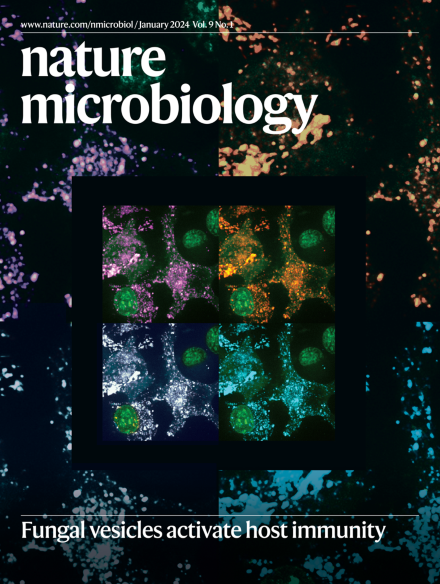Aspergillus cvjetkovicii protects against phytopathogens through interspecies chemical signalling in the phyllosphere
IF 20.5
1区 生物学
Q1 MICROBIOLOGY
引用次数: 0
Abstract
Resident microbiota produces small molecules that influence the chemical microenvironments on leaves, but its signalling roles in pathogen defence are not yet well understood. Here we show that Aspergillus cvjetkovicii, enriched in rice leaf microbiota, subverts Rhizoctonia solani infections via small-molecule-mediated interspecies signalling. 2,4-Di-tert-butylphenol (2,4-DTBP), identified as a key signalling molecule within the Aspergillus-enriched microbiota, effectively neutralizes reactive oxygen species-dependent pathogenicity by switching off bZIP-activated AMT1 transcription in R. solani. Exogenous application of A. cvjetkovicii and 2,4-DTBP demonstrated varying degrees of protective effects against R. solani infection in diverse crops, including cucumber, maize, soybean and tomato. In rice field experiments, they reduced the R. solani-caused disease index to 19.7–32.2%, compared with 67.2–82.6% in the control group. Moreover, 2,4-DTBP showed activity against other rice phytopathogens, such as Fusarium fujikuroi. These findings reveal a defensive strategy against phytopathogens in the phyllosphere, highlighting the potential of symbiotic microbiota-driven neutralization of pathogenicity. Beneficial Aspergillus cvjetkovicii protects host plants against fungal diseases by inactivating pathogenicity-related gene transcription of phytopathogens via 2,4-DTBP signalling.


cvjetkovicii 曲霉通过叶球中的种间化学信号来抵御植物病原体
常驻微生物群产生的小分子可影响叶片上的化学微环境,但其在病原体防御中的信号作用尚未得到充分了解。在这里,我们展示了水稻叶片微生物群中富集的曲霉 cvjetkovicii 通过小分子介导的种间信号转导来颠覆根瘤菌的感染。2,4-二叔丁基苯酚(2,4-DTBP)被确定为曲霉富集微生物群中的一种关键信号分子,它通过关闭 bZIP 激活的 R. solani AMT1 转录,有效地中和了活性氧依赖的致病性。外源施用 A. cvjetkovicii 和 2,4-DTBP 对不同作物(包括黄瓜、玉米、大豆和番茄)的 R. solani 感染具有不同程度的保护作用。在水稻田间试验中,它们将 R. solani 引起的病害指数降低到 19.7-32.2%,而对照组为 67.2-82.6%。此外,2,4-DTBP 对其他水稻植物病原菌,如镰刀菌也有活性。这些发现揭示了植物叶球对植物病原体的防御策略,突出了共生微生物群驱动的中和致病性的潜力。
本文章由计算机程序翻译,如有差异,请以英文原文为准。
求助全文
约1分钟内获得全文
求助全文
来源期刊

Nature Microbiology
Immunology and Microbiology-Microbiology
CiteScore
44.40
自引率
1.10%
发文量
226
期刊介绍:
Nature Microbiology aims to cover a comprehensive range of topics related to microorganisms. This includes:
Evolution: The journal is interested in exploring the evolutionary aspects of microorganisms. This may include research on their genetic diversity, adaptation, and speciation over time.
Physiology and cell biology: Nature Microbiology seeks to understand the functions and characteristics of microorganisms at the cellular and physiological levels. This may involve studying their metabolism, growth patterns, and cellular processes.
Interactions: The journal focuses on the interactions microorganisms have with each other, as well as their interactions with hosts or the environment. This encompasses investigations into microbial communities, symbiotic relationships, and microbial responses to different environments.
Societal significance: Nature Microbiology recognizes the societal impact of microorganisms and welcomes studies that explore their practical applications. This may include research on microbial diseases, biotechnology, or environmental remediation.
In summary, Nature Microbiology is interested in research related to the evolution, physiology and cell biology of microorganisms, their interactions, and their societal relevance.
 求助内容:
求助内容: 应助结果提醒方式:
应助结果提醒方式:


